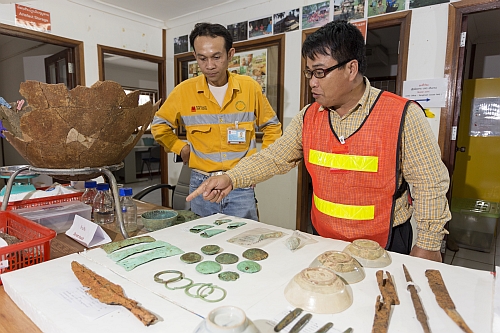Evidence of ancient copper mining in Vilabouly District, Savannakhet Province where Sepon mine is located offers a unique window into the history of metallurgy in Southeast Asia. MMG LXML Sepon (LXML) is supporting the discovery and preservation of Lao history through its cultural heritage program.
Prehistoric mining at Sepon was conducted in an unusual way. Communities dug vertical shafts up to 40m deep reinforced with wooden bracing. Radiocarbon dating from wood, bamboo and rattan supports confirm that family-based traditional mining took place for 50 generations, or around 2,500 years, in the area.
Copper artefacts sharing the same signature as ore from Sepon indicate mining began here around 3,000 years ago. At Thengkham, range vertical shafts were carbon dated from between 2,460 and 1,330 years ago. Such a wide date range is unique and shows that Sepon has produced copper for thousands of years.
Some of the most interesting artefacts unearthed include a large bronze drum and long canoes buried 10m below the surface, as well as a pot containing 4,000 glass, agate and carnelian beads, bronze bells and other jewellery. Some of these items are on display in Savannakhet and the Lao National Museum in Vientiane.
LXML has sponsored archaeological research since 2008 in cooperation with the Lao Department of National Heritage and James Cook University. This fieldwork unites a unique community at local, national and international levels. Volunteers from Vientiane, local villagers, Australian students, archaeologists and Lao officials cooperate closely together to conduct research. LXML constructed a cultural hall in Vilabouly to preserve artefacts and showcase traditional Lao cultural heritage for communities, visitors and tourists.
In April 2015, to enhance regional cooperation, LXML sponsored a Lao official, Mr Somchanh Chongbaikham from the Savannakhet Department of Information, Culture and Tourism, to attend a conference on archaeology and heritage preservation in Yunnan Province in the People’s Republic of China.
Mining has been essential in the development of civilisation and society throughout history. Excavations are continuing and we look forward to revealing more exciting discoveries about Lao culture and history.
